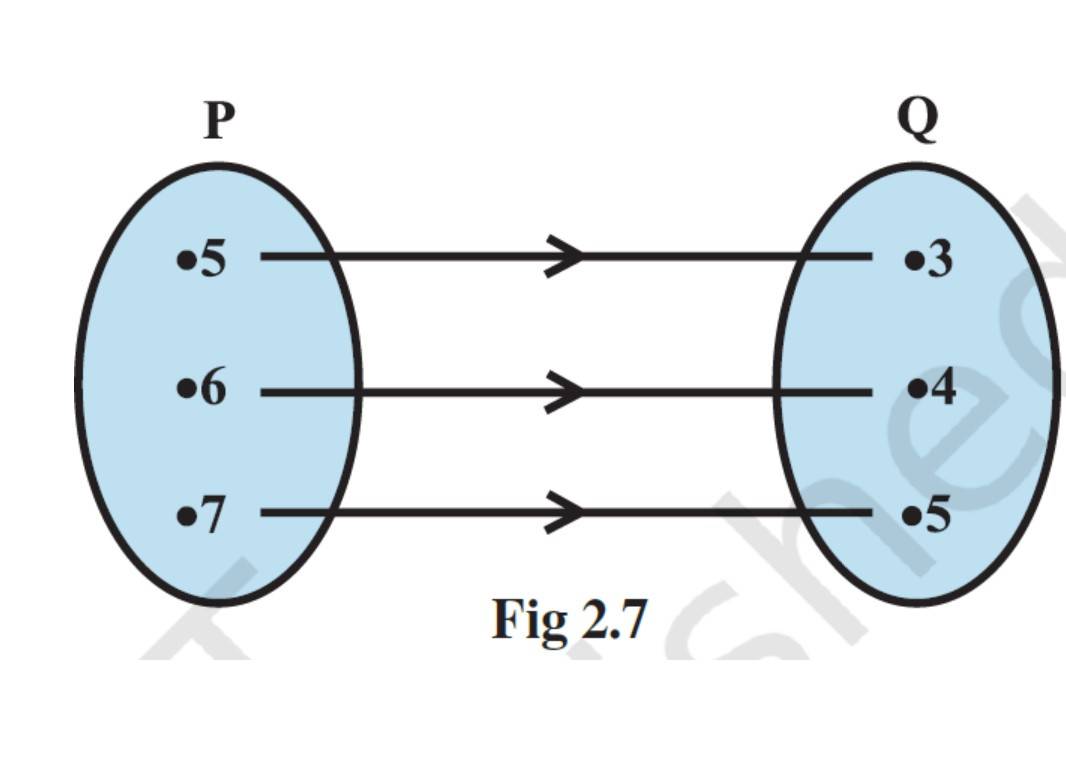Relations and Functions
Get insights from 232 questions on Relations and Functions, answered by students, alumni, and experts. You may also ask and answer any question you like about Relations and Functions
Follow Ask QuestionQuestions
Discussions
Active Users
Followers
New answer posted
7 months agoContributor-Level 10
16. Given, R = { (x, x+5): x {0,1,2,3,4,5}
= { (0,0+5), (1,1+5), (2,2+5), (3,3+5), (4,4+5), (5,5+5)}
= { (0,5), (1,6), (2,7), (3,8), (4,9), (5,10)}
So, domain of R= {0,1,2,3,4,5}
range of R= {5,6,7,8,9,10}
New answer posted
7 months agoContributor-Level 10
15. Given, A= {1,2,3,4,6}
R= { (a, b): a, b A, b is exactly divisible by a}
(i) R= { (1,1), (1,2), (1,3), (1,4), (1,6), (2,2), (2,4), (2,6), (3,3), (3,6), (4,4), (6,6)}
(ii) Domain of R= {1,2,3,4,6}
(iii) Range of R= {1,2,3,4,6}
New answer posted
7 months agoContributor-Level 10
14. As R is a relation from set P to Q.
(i) R = { (x, y): x – 2 = y ; 5 ≤ x ≤ 7}
(ii) R = { (5,3), (6,4), (7,5)}
Domain of R= {5,6,7}
range of R= {3,4,5}
New answer posted
7 months agoContributor-Level 10
13. Given, A= {1,2,3,5}
B= {4,6,9}
R= { (x, y) : the difference of x & y is odd; x A, y B}.
= { (x, y):|x – y| is odd and x A, y B}
= { (1,4), (1,6), (2,9), (3,4), (3,6), (5,4), (5,6)}.

New answer posted
7 months agoContributor-Level 10
12. Given, R = { (x, y): y = x + 5, x is a natural number less than 4; x, y N}
= { (x, y): y = x + 5; x, y N and x < 4}.
= { (1,1+5), (2,2+5), (3,3+5)}
= { (1,6), (2,7), (3,8)}
So, domain of R = {1,2,3}
range of R = {6,7,8}
New answer posted
7 months agoContributor-Level 10
11. Given, A = {1,2,3, …, 14}
R = { (x, y): 3x – y = 0; x, y A}
= { (x, y): 3x = y; x, y A}.
= { (1,3), (2,6), (3,9), (4,12)}
Domain of R is the set of all the first elements of the ordered pairs in R
So, domain of R= {1,2,3,4}
Codomain of R is the whole set A.
So, codomain of R= {1,2,3, …, 14}
Range of R is the set of all the second elements of the ordered pains in R.
So, range of R= {3,6,9,12}
New question posted
7 months agoNew answer posted
7 months agoContributor-Level 10
10. Given, n (A * A)=9
n (A) *n (A) = 9.
n (A)2 = 32.
n (A) = 3 .
And (–1,0), (0,1) A * A i.e., A * A = { (x, y), x A, y B}
? A= {–1,0,1}
And A * A= {–1,0,1} * {–1,0,1}
= { (–1, –1), ( –1,0), ( –1,1), (0, –1), (0,0), (0,1), (1, –1), (1,0), (1,1)}
New answer posted
7 months agoContributor-Level 10
9. Given, n (A)=3
n (B)= 2
So, n (Ax B)=n (A).n (B)=3x 2=6
as (x, 1), (y, 2), (z, 1) ∈Ax B= { (x, y), x∈Aand y∈B}.
A= {x, y, z} and B= {1,2}
As n (A) = 3as n (B) = 2
New answer posted
7 months agoContributor-Level 10
8. A Given, A= {1,2}
B= {3,4}
So, A* B= { (1,3), (1,4), (2,3), (2, 4)}
i.e., n (A *B)=4
A *B will have subset =24=16.They are,
Φ, { (1,3)}, { (1,4)}, { (2, 3)}, { (2,4)}, { (1,3), (1,4)}, { (1,3), (2,3)},
{ (1,3), (2, 4)}, { (1,4), (2, 3)}, { (1,4), (2, 4)}, { (2,3), (2, 4)},
{ (1,3), (1,4), (2, 3)}, { (1,3), (1,4), (2,4)}, { (1,3), (2,3), (2, 4)}, { (1,4), (2,3), (2,4)},
and { (1,3), (1,4), (2,3), (2,4)}
Taking an Exam? Selecting a College?
Get authentic answers from experts, students and alumni that you won't find anywhere else
Sign Up on ShikshaOn Shiksha, get access to
- 66k Colleges
- 1.2k Exams
- 680k Reviews
- 1800k Answers
